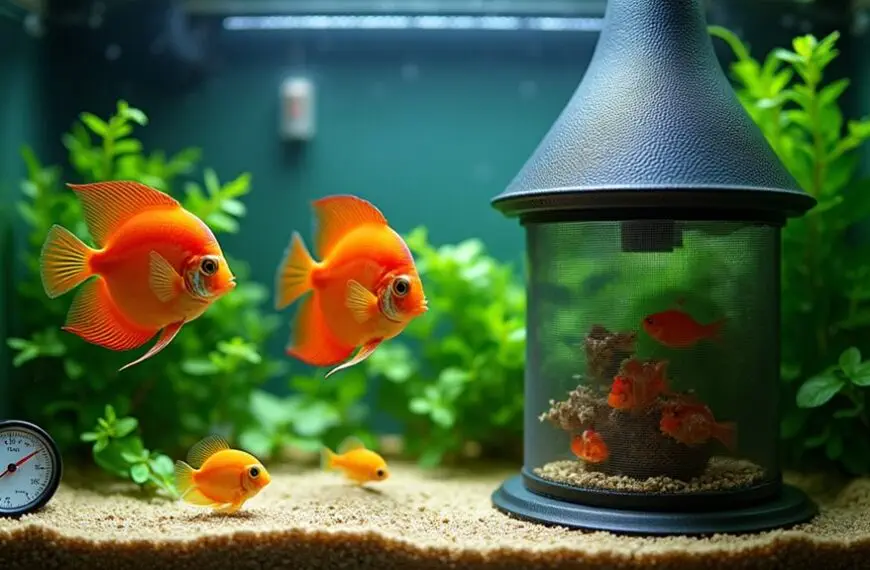If you're looking to breed freshwater fish, consider guppies, angelfish, or bristlenose plecos. Guppies are super easy and can pop out 20-40 tiny fry each month—talk about a fishy family reunion! Angelfish aren't just pretty; they lay up to 1,000 eggs every few weeks. Plus, bristlenose plecos make your tank sparkly clean while being low-maintenance. You'll want to create cozy spots for them to spawn and keep an eye on water conditions to encourage a successful breeding. Trust me, it's a fun hobby! Stick around, and you'll uncover more tips on how to become a fish-breeding pro.
Contents
Top Freshwater Fish for Breeding
When it comes to breeding freshwater fish, enthusiasts often find themselves drawn to a few standout species that make the process both enjoyable and rewarding. First up are Guppies, the live bearers that seem to have a knack for multiplying! With females giving birth to 20-40 fry every month, you'll soon have more than you bargained for.
These hardy fish thrive in groups and are easy to care for, making them perfect for breeding in a well-planted environment creating a well-planted environment.
If you're looking for something a bit different, consider Bristlenose Plecos. They prefer cozy cave-like spots to spawn and can sell for $10-$30 each, depending on their variety.
Angelfish are another great option, spawning every 7-9 days and laying up to 1,000 eggs at a time. They're not just pretty; they can also help you breed for profit, fetching $8 to $14 per fish.
Don't overlook Neocaridina shrimp, like the vibrant cherry shrimp, which are perfect for aquarium hobbyists wanting rapid reproduction and colorful additions to their tanks.
Lastly, Dwarf Cichlids, such as Apistogramma spp., are prized for their caring nature and unique behaviors, selling for up to $30 each.
With these fantastic fish, your breeding tank will be buzzing with life and excitement!
Essential Breeding Techniques
Mastering essential breeding techniques is crucial for anyone looking to successfully raise freshwater fish. With the right approach, you can create a nurturing environment for your fish. Here are four key techniques to enhance your breeding success:
1. Scheduled Spawning: Set a regular schedule for spawning, especially for fish like guppies and angelfish. This keeps fry production consistent throughout the year.
Additionally, consider incorporating species like rasboras which thrive in community setups, as they can also be bred effectively in a controlled environment.
2. Breeding Boxes: Use breeding boxes or separate tanks to protect your fry from adult fish. This safe haven allows them to grow without the threat of being eaten.
3. Water Parameters: Always maintain optimal water conditions. Each species has its preferences—like slightly acidic pH for dwarf cichlids.
Understanding these needs can trigger breeding behaviors.
4. Diet Conditioning: Feed your breeding pairs high-quality live foods. This not only improves their health but also boosts spawning success and the wellbeing of the fry.
Don't forget about egg and fry care!
Regular water changes and removing uneaten food help prevent contamination. By implementing these techniques, you're setting your fish up for a thriving future. Happy breeding!
Financial Aspects of Fish Breeding

Financially, breeding freshwater fish can often be a rewarding venture, but it's essential to approach it with a solid understanding of the costs involved.
You'll need to consider your initial investments, which can range from a few hundred to several thousand dollars, depending on the setup you choose and the species you want to breed. It's important to select hardy species that breed well in captivity, such as guppies and bettas, as these have been known to adapt easily to breeding conditions and yield larger school numbers.
While common fish like guppies may yield low profit margins of about $0.10 each, rare species can sell for upwards of $30 with diverse species selection.
Don't forget to factor in operating costs like water, electricity, and maintenance. These can really add up, especially in areas with high utility prices.
If you're thinking about selling your fish, remember that local market rates often give lower returns compared to online platforms, where you can reach a larger audience.
Breeding high-quality species, such as rare cichlids or high-grade discus, can be lucrative but requires careful financial planning. They demand higher initial investments and a bit more TLC.
Factors Influencing Breeding Success
Successful breeding of freshwater fish hinges on several key factors that you need to keep in mind.
To set your breeding pairs up for success, focus on these essentials:
1. Genetic Compatibility: Ensure your breeding pairs are compatible. This maximizes healthy fry and strong bloodlines, making your efforts worthwhile.
2. Water Parameters: Keep those water parameters in check! Maintain optimal pH, temperature, and ammonia levels to create a cozy breeding environment.
3. Sheltered Spaces: Providing spawning boxes and floating plants gives fry a safe haven from hungry adults.
Think of it as a fishy daycare—got to keep them safe!
4. Diet and Health: Feed your breeding pairs a diet rich in live food. This not only conditions them but also sparks reproductive behaviors, boosting fertility rates.
Common Challenges in Breeding

Breeding freshwater fish can be rewarding, but it also comes with its share of challenges. One of the trickiest parts is gender identification. If you mix up the males and females, you might end up with some feisty fish fights instead of adorable fry!
Disease management is another key concern. Regular health checks and water quality monitoring can help you spot issues before they become disasters, keeping your breeding setups healthy.
Don't forget about overcrowding, either. Too many fish in a tank can stress them out, leading to competition for food and space. So, practicing good stock management is vital to create those optimal conditions for breeding.
You'll also want to keep an eye on your equipment. Regular maintenance is a must, since equipment failures can happen when you least expect it.
Lastly, market demand can shift suddenly, leaving you with more fish than you can sell. Staying informed about trends can help you adjust your breeding strategies accordingly.
With a little diligence and a sense of humor, you can navigate these challenges and enjoy the journey of breeding freshwater fish!
Frequently Asked Questions
What Freshwater Fish Are Easiest to Breed?
When you're considering the easiest freshwater fish to breed, focus on species like guppies or mollies. Ensure proper breeding tanks, monitor water parameters, and provide suitable fry care while selecting compatible tank mates and understanding their spawning behavior.
Which Fish Is Best for Breeding?
When choosing fish for breeding, consider their breeding behavior, tank setup, and water parameters. Understand spawning triggers, fry care, and food requirements to ensure success while managing common challenges and temperature control throughout breeding seasons.
What Fish Reproduces the Fastest?
If you're looking for fast-reproducing fish, consider guppies or zebra danios. Their reproductive habits include frequent spawning, quick growth rates, and unique mating rituals, making them ideal for beginners in caring for fry and breeding conditions.
What Is the Easiest Egg Laying Fish to Breed for Beginners?
If you're seeking the easiest egg-laying fish for beginners, consider Tetras. They thrive in simple setups, need specific water parameters, and require attention to fry care, spawning behavior, and proper diet requirements with suitable tank mates.
Final Thoughts
Breeding freshwater fish can be a rewarding adventure, like planting seeds in a garden and watching them flourish. With the right techniques and a sprinkle of patience, you can create a thriving underwater community. Just remember, every fish has its quirks, and some days might feel like a rollercoaster ride. Embrace the challenges, celebrate the successes, and soon you'll find yourself swimming in joy. So grab your nets, dive in, and let the fishy fun begin!












